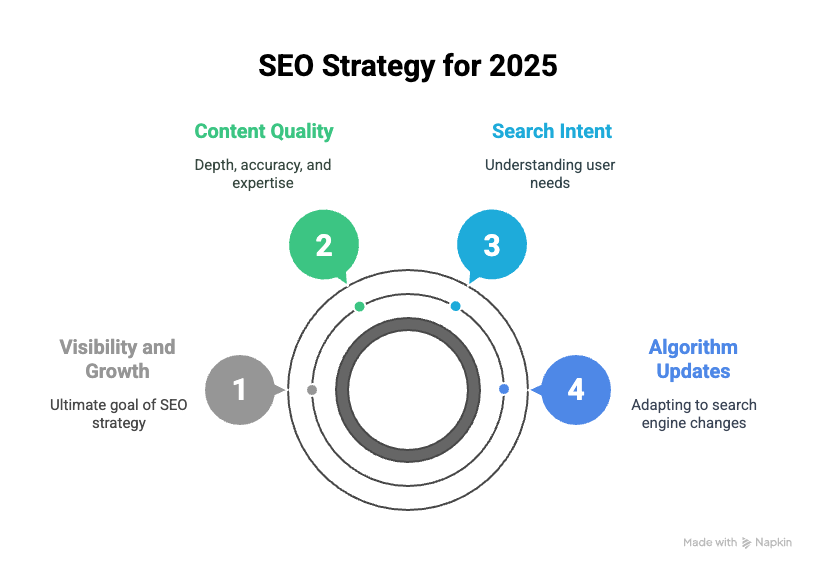The Future of SEO is Now: Growth & Visibility
- Ashley Wilson
- Jun 11
- 4 min read
SEO has changed more in the past two years than it did in the previous ten. This shift is not just about algorithm updates or new ranking factors — it’s about how search engines understand intent, content, and authority at scale. In 2025, businesses that align with these changes can benefit from long-term visibility and sustainable growth.
This article explores how SEO is evolving, which practices matter most today, and what growth-focused marketers should focus on to stay visible in a competitive search landscape.|
Search Intent Has Replaced Keyword Stuffing
Search engines now interpret user queries based on context, not just exact keywords. The days of loading pages with phrases like “best digital marketing services in Delhi” are over. Today, it’s about satisfying the intent behind that search.
Why Search Intent Matters More Than Ever
Google uses semantic analysis and machine learning to match content to search goals. This means that pages written to answer real user questions — clearly and concisely — tend to perform better.
Instead of focusing only on keyword density, sites need to:
Structure answers using relevant subtopics
Match informational, navigational, and transactional intent
Reduce fluff and stick to the user’s core need
Example: A user searching “best time to invest in mutual funds” wants guidance, not a long list of fund houses. Pages that directly address the timing and offer clear reasoning are now preferred.

Content Quality Now Means Depth and Accuracy
Search engines now assess content quality with far greater accuracy. Thin or superficial pages are unlikely to rank, even if well-optimized.
What Defines High-Quality Content in 2025
Content that demonstrates expertise, supports claims with references, and delivers clear takeaways is considered high quality. Here are the key markers:
Content is authored by a verified expert or professional
Information is updated and factually accurate
Pages are structured with H1, H2, and H3 tags for readability
Internal and external linking provides further depth
This aligns with Google's EEAT principles — expertise, experience, authoritativeness, and trustworthiness — which continue to influence visibility.
Page Experience Signals Have Become Mandatory
User experience (UX) is now inseparable from SEO. Metrics like site speed, mobile responsiveness, and layout stability directly affect rankings.
Why Technical SEO and UX Go Hand in Hand
A technically optimized page that loads quickly and displays properly on all devices is now a basic expectation. To improve both rankings and conversions:
Ensure Core Web Vitals are within Google’s thresholds
Use clear CTAs without disruptive pop-ups
Enable fast server response and mobile-friendly layouts
These changes emphasize that SEO is not just about content, but also about how that content is delivered.
Authority and Topical Relevance Are Outranking Backlinks
Search engines are now placing more value on topical depth and internal consistency than on backlink quantity alone.
Building Topic Authority Beats Chasing Links
To build authority, focus on creating a full ecosystem of content around your niche. For example, a financial blog covering gold loans, mutual funds, and SIP calculators should aim to:
Interlink related pages consistently
Cover all subtopics users might search around a core subject
Regularly update existing articles with new data
This strategy helps Google recognize your domain as a reliable source within a topic — which leads to sustained growth and rankings.
Structured Data and Semantic Markup Improve Visibility
Structured data helps search engines better understand content and feature it in enhanced search results like FAQs, how-tos, and product reviews.
Why Schema Markup Is No Longer Optional
Pages with correct schema implementation are more likely to appear in rich results. This leads to:
Higher click-through rates
Better visibility in voice and mobile search
Improved chances of zero-click placements
Use schema for:
FAQs
Product pages
Articles
Reviews
Events
Implementation via JSON-LD is recommended, and all markup should be validated via Google’s Rich Results Test tool.
Zero-Click Searches Are Increasing — And That’s Okay
With more results showing featured snippets, People Also Ask, and direct answers, many users get what they need without clicking. This doesn’t mean SEO is losing value.
Visibility Now Includes No-Click Outcomes
Even when users don’t click, brand visibility within the SERP still has value. Being shown in answer boxes or knowledge panels enhances trust and recall.
To adapt:
Structure answers in short, clear formats
Use bullet points for definitions and summaries
Optimize titles and headers for exact-match queries
Your brand’s presence — even without a click — supports recognition and future traffic.
SEO Is No Longer Standalone — It's Integrated
Search no longer operates in isolation. Performance in search now intersects with social signals, video content, app visibility, and even voice search.
Multi-Channel Alignment Affects SEO Outcomes
To support visibility and growth, align your SEO strategy with:
Branded social content
YouTube search optimization
App Store metadata (ASO) for mobile-first users
Integrated digital ecosystems reinforce your domain’s presence across all user touchpoints.
Conclusion:
As the landscape shifts, SEO strategies must mature beyond technical checklists and content hacks. Visibility today is earned through authority, clarity, and structure. Growth is achieved by integrating SEO into broader digital marketing functions — not by treating it as a silo.
The future of SEO is now: Growth & visibility is no longer a theory — it’s the reality businesses must optimize for today.

Comments